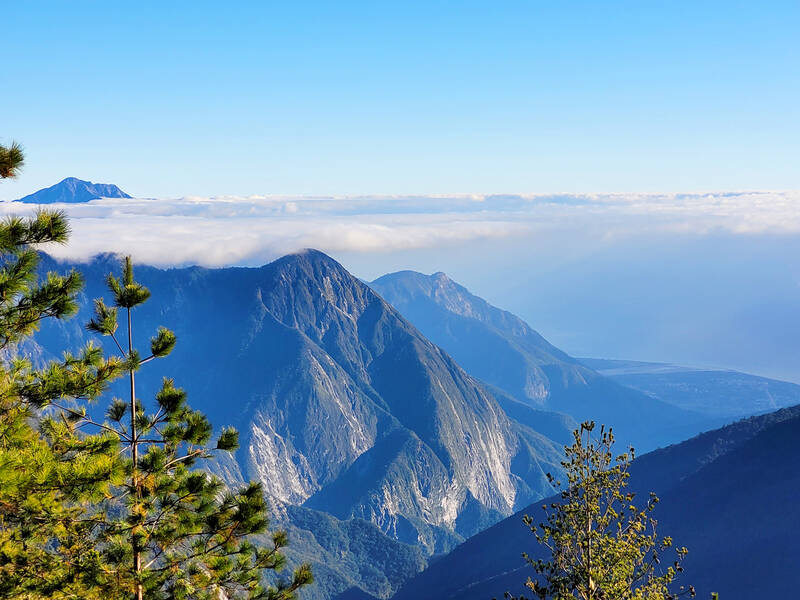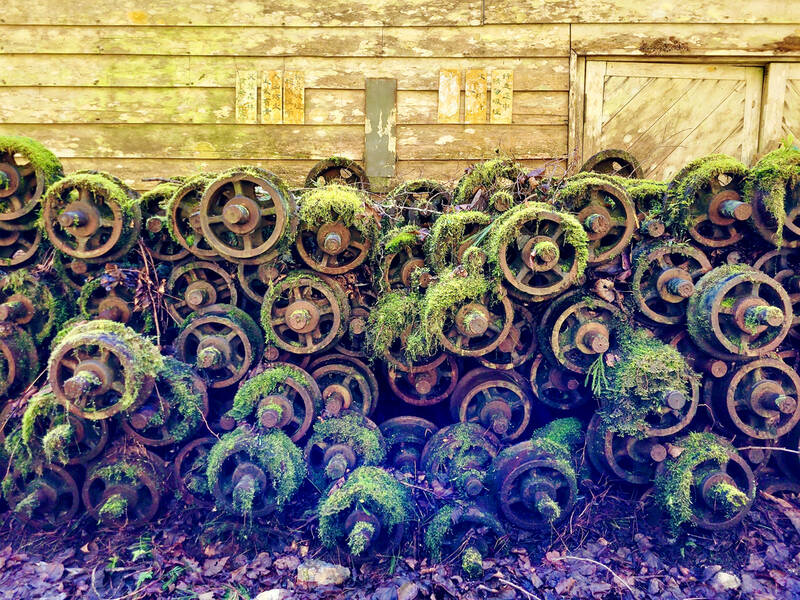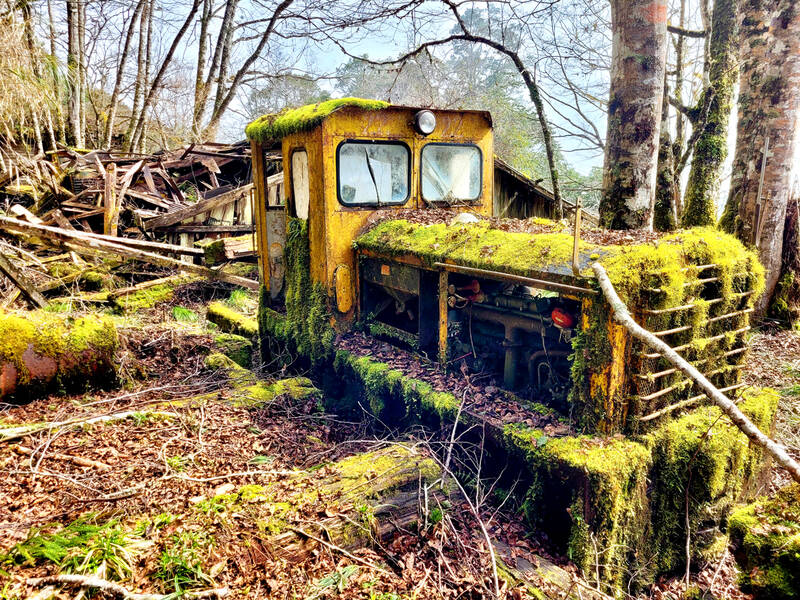On the final approach to Lanshan Workstation (嵐山工作站), logging trains crossed one last gully over a dramatic double bridge, taking the left line to enter the locomotive shed or the right line to continue straight through, heading deeper into the Central Mountains. Today, hikers have to scramble down a steep slope into this gully and pass underneath the rails, still hanging eerily in the air even after the bridge’s supports collapsed long ago.
It is the final — but not the most dangerous — challenge of a tough two-day hike in. Back when logging was still underway, it was a quick, easy ride up from Hualien City via a series of cableways and railways. Nowadays, hikers must take an alternative route along a ridge, only descending to the railway after the last impassable obstacle for the final two kilometers.
Once you finally make it to Lanshan Workstation, it is worth sticking around for at least a half-day if not a full day. The sheer size of the place and the number of buildings still standing are enough to keep you busy exploring for hours.

Photo: Tyler Cottenie
WORKING LIFE
Along the main tracks as you walk in are the buildings where people did their work at Lanshan. On the left are three partially collapsed buildings — the locomotive shed, the power plant and the lumber processing station — and a still-intact fueling station. Several locomotives are scattered in and around these buildings, still sitting on the rails where they were parked on their last working day back in 1989. Less than four meters long, with their cabs covered in flaking yellow paint and the rest in a layer of moss, these tiny logging locomotives are among the most photogenic relics at Lanshan today.
A little further ahead are some of the best-preserved buildings at the site. On the left are a concrete building and a wooden building. The former holds firefighting equipment, and thanks to its concrete walls, intact windows, and roll-up steel door that is still down and locked, the interior (as seen through a window) has been almost perfectly preserved. The adjacent wooden building was the store, and though the shelves are now bare, the handwritten labels displaying the items and their prices—canned lychee for NT$16, AA batteries for NT$3 each, men’s underwear for NT$26—make it easy to imagine what it looked like when it was operational.

Photo: Tyler Cottenie
On the opposite side of the tracks was the administrative heart of the workstation. Two staircases with a flagpole in the middle are flanked by metal signs bearing slogans encouraging workers to dedicate themselves to their logging grounds. At the top sits the blue-painted office building with its roof and walls still miraculously intact.
This space is full of interesting curiosities, like the board displaying name plates for workers, some of whom are undoubtedly still living in the lowlands, unaware that the occasional hiker still catches a glimpse of their name here, frozen in time. Also frozen in time are the work details from April of 1989, written on a chalkboard hanging on the back wall, still untouched by visitors in the decades since.
Perhaps most surprising of all is the still-intact portrait of Chiang Kai-shek (蔣介石). With the changing political climate since the 1980s, it’s hard to believe that this big smiling dictator hasn’t been the object of vandalism, but there it remains, a concrete link to Taiwan’s economically thriving but politically strained past.

Photo: Tyler Cottenie
LIFE OUTSIDE OF WORK
Traces of daily life outside of work are everywhere on the site. The center of religious life, Rongshan Temple, is right next to the office building, up a short flight of stairs. This sturdy structure’s interior is still protected from the elements, preserving the altar and decorations. The incense burner and joss paper furnace still stand outside and appear to see occasional use.
Just behind the store and firefighting equipment storage building, a fan-shaped concrete staircase leads to the lower level of the workstation. This is where workers headed after hours to eat, play and sleep.

Photo: Tyler Cottenie
Ten dormitory buildings for workers are scattered throughout this lower level, in various states of dilapidation. In those still standing, most — but not all — of the wooden floors have rotted away, and artifacts lie on the ground and in open closets everywhere: old cassette tapes, calendars, toys, clothing, furniture and more. A small bicycle and tiny shoes are evidence that some men did have their families here, while the magazine pages of nude women pinned up in other rooms suggest that some were up here on their own.
The station manager had his own personal dormitory in the southeast corner. Of note here is the portable electric heater sitting on the floor. Considering the station’s electricity was generated by burning fuel on site, the use of a high-power appliance like this was likely a privilege only accorded to the manager. The workers’ dormitories were heated only by small wood stoves, some of which are still in place.
The dining hall, bathhouses and sports field are ruined to the point that they are hard to enter, but the recreation hall is still standing. The walls on one side have fallen away and sambar deer can now enter and use this large space as their own social gathering space (and toilet).
Back when only humans gathered here, this lively space could be divided in half by a sliding door to accommodate different activities at the same time. One of the perks of working somewhere with railway access was that, despite the remoteness, large items could still be brought in, like the ping-pong table and billiards table in this hall. The original set of snooker balls and several cues are still here, and the pockets and cloth are all in decent enough shape to actually have a proper game on the table.
GETTING IN AND OUT
Getting to Lanshan Workstation from Hualien City starts with a hike up to Chuyin Mountain (初音山), one of the Small 100 Peaks. From there, you continue up the ridge to Cijiaochuan Mountain (七腳川山), sleeping at a hunter’s campsite along the way, and then descend along the ridge until you are above Tunnel No. 3. A steep forest slope on the left leads down to the rail line just as it comes out of the tunnel. Following the rail line from here takes you directly to the workstation.
However, after decades of abandonment, the rail line has suffered from numerous washouts and bridge collapses. In places, it’s possible to detour off the rail line along a narrow path that hugs the mountain wall instead of walking on a rickety old bridge. But in at least two places, the mountain is a sheer cliff, so there is no choice but to walk directly on the rotting wooden bridge. Some of the wooden beams are so rotten and mossy that it is actually safer to step directly on the slippery but solid steel rails.
This section was so unnerving that, instead of returning to Hualien along the same path, the author decided to exit via a different route, following the main railway deeper into the mountains, climbing the next ridge up to Rong Mountain (榮山) — where an old forest fire watchtower made for a lovely night’s stay — and then continuing down the opposite side to rejoin the inbound route above Tunnel No. 3.
Visiting Lanshan Workstation is an advanced four-day route with multiple risks and no maintained trail infrastructure. It should not be attempted without previous experience navigating off trail in Taiwan’s mountains, as well as redundant navigation and safety gear.
Browse the Forestry Bureau’s book Lanshan — Distant and Distinct for more information, for old photographs, or for maps that may assist in planning a visit: theme.forest.gov.tw/ebook/002/ (contains English translations).

US President Donald Trump may have hoped for an impromptu talk with his old friend Kim Jong-un during a recent trip to Asia, but analysts say the increasingly emboldened North Korean despot had few good reasons to join the photo-op. Trump sent repeated overtures to Kim during his barnstorming tour of Asia, saying he was “100 percent” open to a meeting and even bucking decades of US policy by conceding that North Korea was “sort of a nuclear power.” But Pyongyang kept mum on the invitation, instead firing off missiles and sending its foreign minister to Russia and Belarus, with whom it

When Taiwan was battered by storms this summer, the only crumb of comfort I could take was knowing that some advice I’d drafted several weeks earlier had been correct. Regarding the Southern Cross-Island Highway (南橫公路), a spectacular high-elevation route connecting Taiwan’s southwest with the country’s southeast, I’d written: “The precarious existence of this road cannot be overstated; those hoping to drive or ride all the way across should have a backup plan.” As this article was going to press, the middle section of the highway, between Meishankou (梅山口) in Kaohsiung and Siangyang (向陽) in Taitung County, was still closed to outsiders

President William Lai (賴清德) has championed Taiwan as an “AI Island” — an artificial intelligence (AI) hub powering the global tech economy. But without major shifts in talent, funding and strategic direction, this vision risks becoming a static fortress: indispensable, yet immobile and vulnerable. It’s time to reframe Taiwan’s ambition. Time to move from a resource-rich AI island to an AI Armada. Why change metaphors? Because choosing the right metaphor shapes both understanding and strategy. The “AI Island” frames our national ambition as a static fortress that, while valuable, is still vulnerable and reactive. Shifting our metaphor to an “AI Armada”

The Chinese Communist Party (CCP) has a dystopian, radical and dangerous conception of itself. Few are aware of this very fundamental difference between how they view power and how the rest of the world does. Even those of us who have lived in China sometimes fall back into the trap of viewing it through the lens of the power relationships common throughout the rest of the world, instead of understanding the CCP as it conceives of itself. Broadly speaking, the concepts of the people, race, culture, civilization, nation, government and religion are separate, though often overlapping and intertwined. A government